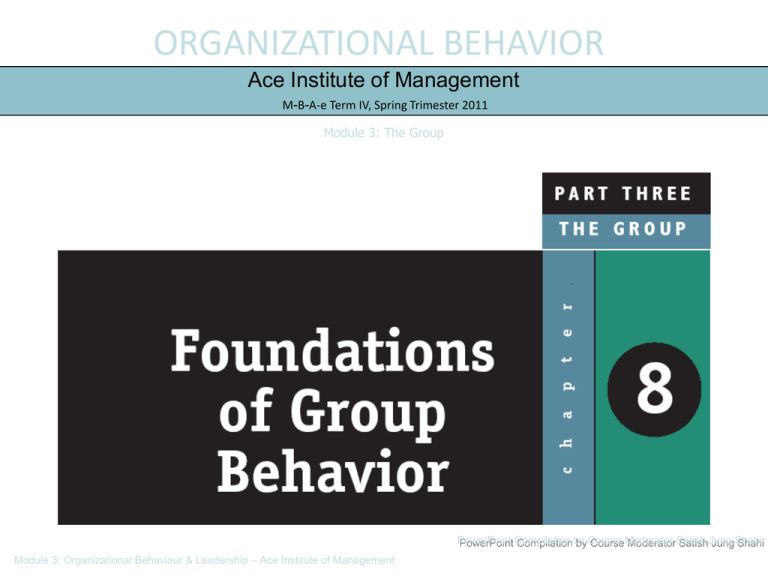
ORGANIZATIONAL BEHAVIOR
Ace Institute of Management
M-B-A-e Term IV, Spring Trimester 2011
Module 3: The Group
PowerPoint Compilation by Course Moderator Satish Jung Shahi
Module 3: Organizational Behaviour & Leadership – Ace Institute of Management
Defining and Classifying Groups
E.g.: N-I-B-L, Laxmi Bank,
Himalayan Expeditions, etc.
E.g.: Three employees eating
lunch together.
© 2003 Prentice Hall Inc. All
rights reserved.
Defining and Classifying Groups (cont’d)
E.g.:
Ace
Institute
of
Management, M-B-A Faculty.
E.g.: Employees who band
together to support a peer who
has been fined.
© 2003 Prentice Hall Inc. All
rights reserved.
E.g.: College management, Program
Coordinator,
Student
Council
representatives, and director of
security may form a group to deal with
campus crime.
E.g.: Within M-B-A, Term II.
Why People Join Groups
• Security
• Status
• Self-esteem
• Affiliation
• Power
• Goal Achievement
EXHIBIT
© 2003 Prentice Hall Inc. All
rights reserved.
8-1
Stages of Group Development
EXHIBIT
© 2003 Prentice Hall Inc. All
rights reserved.
8-2
Punctuated Equilibrium (For
temporary groups with deadlines):
Sequence of actions:
1. Setting group direction
2. First phase of inertia
3. Half-way point transition
4. Major changes
5. Second phase of inertia
6. Accelerated activity
© 2003 Prentice Hall Inc. All
rights reserved.
The Punctuated-Equilibrium Model
EXHIBIT
© 2003 Prentice Hall Inc. All
rights reserved.
8-3
Group Structure - Roles
E.g.: Students into teachers.
E.g.: A top level manager is perceived as
being reserved, rich, commanding etc.
© 2003 Prentice Hall Inc. All
rights reserved.
Group Structure - Roles (cont’d)
E.g.: Zimbardo's simulated Prison.
© 2003 Prentice Hall Inc. All
rights reserved.
Group Structure - Norms
Classes of Norms:
• Performance norms: It provides
cues on how the work should be
done.
• Appearance norms: It relates to
issues such as dress code, loyalty
to work, when to look busy, when to
have fun, so on.
• Social arrangement norms: It is
informal in nature and relates to
social interactions within the group.
• Allocation of resources norms: It
relates to issues such as pay,
assignment, so on.
© 2003 Prentice Hall Inc. All
rights reserved.
Group Structure - Status
Group Norms
Status Equity
Culture
© 2003 Prentice Hall Inc. All
rights reserved.
Group Member
Status
Group Structure - Size
Performance
Other conclusions:
• Odd number groups do
better than even.
Group Size
© 2003 Prentice Hall Inc. All
rights reserved.
• Groups of 7 or 9 perform
better overall than larger or
smaller groups.
Group Structure - Composition
© 2003 Prentice Hall Inc. All
rights reserved.
Group Structure - Cohesiveness
Increasing group cohesiveness:
1.
2.
3.
4.
5.
6.
7.
© 2003 Prentice Hall Inc. All
rights reserved.
Make the group smaller.
Encourage agreement with group goals.
Increase time members spend together.
Increase group status and admission difficultly.
Stimulate competition with other groups.
Give rewards to the group, not individuals.
Physically isolate the group.
Relationship Between Group
Cohesiveness, Performance Norms,
and Productivity
EXHIBIT
© 2003 Prentice Hall Inc. All
rights reserved.
8-7
Simulation 1: “Brick Game”
Simulation 1: “Brick Game”
Three volunteers, who will role play a manager,
supervisor and worker, are expected to complete a
task assigned in the class. The task will be repeated
again with the manager playing the role of a
worker.
Please observe the proceedings while both the tasks
are being performed.
There is no grading for Simulation 1.
© 2003 Prentice Hall Inc. All
rights reserved.
Why Have Teams Become So Popular
• Teams typically outperform individuals.
• Teams use employee talents better.
• Teams are more flexible and responsive to
changes in the environment.
• Teams facilitate employee involvement.
• Teams are an effective way to democratize an
organization and increase motivation.
© 2003 Prentice Hall Inc. All
rights reserved.
Team Versus Groups: What’s the
Difference
© 2003 Prentice Hall Inc. All
rights reserved.
Comparing Work Groups and Work
Teams
EXHIBIT
© 2003 Prentice Hall Inc. All
rights reserved.
9-1
Types of Teams
E.g.: A-I-M, Management & Faculty.
E.g.: I-T.
© 2003 Prentice Hall Inc. All
rights reserved.
Types of Teams (cont’d)
• Task forces
• Committees
E.g.: Marketing & Production
managers unite after a failed
product launch.
© 2003 Prentice Hall Inc. All
rights reserved.
Types of Teams (cont’d)
Team Characteristics
1. The absence of paraverbal and nonverbal cues
2. A limited social context
3. The ability to overcome time and space constraints
© 2003 Prentice Hall Inc. All
rights reserved.
Beware: Teams Aren’t Always the
Answer
• Three tests to see if a team fits the situation:
– Is the work complex and is there a need for
different perspectives?
– Does the work create a common purpose or set of
goals for the group that is larger than the
aggregate of the goals for individuals?
– Are members of the group involved in
interdependent tasks?
© 2003 Prentice Hall Inc. All
rights reserved.
A TeamEffectiveness
Model
EXHIBIT
© 2003 Prentice Hall Inc. All
rights reserved.
9-3
Team and Workforce Diversity:
Advantages and Disadvantages of
Diversity
EXHIBIT
© 2003 Prentice Hall Inc. All
rights reserved.
9-5








